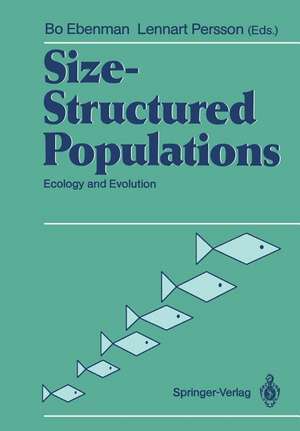Size-Structured Populations: Ecology and Evolution
Editat de Bo Ebenman, Lennart Perssonen Limba Engleză Paperback – 7 dec 2011
Preț: 1001.19 lei
Preț vechi: 1220.96 lei
-18% Nou
Puncte Express: 1502
Preț estimativ în valută:
191.60€ • 199.30$ • 158.18£
191.60€ • 199.30$ • 158.18£
Carte tipărită la comandă
Livrare economică 15-29 aprilie
Preluare comenzi: 021 569.72.76
Specificații
ISBN-13: 9783642740039
ISBN-10: 3642740030
Pagini: 300
Ilustrații: XIV, 284 p.
Dimensiuni: 170 x 244 x 16 mm
Greutate: 0.48 kg
Ediția:Softcover reprint of the original 1st ed. 1988
Editura: Springer Berlin, Heidelberg
Colecția Springer
Locul publicării:Berlin, Heidelberg, Germany
ISBN-10: 3642740030
Pagini: 300
Ilustrații: XIV, 284 p.
Dimensiuni: 170 x 244 x 16 mm
Greutate: 0.48 kg
Ediția:Softcover reprint of the original 1st ed. 1988
Editura: Springer Berlin, Heidelberg
Colecția Springer
Locul publicării:Berlin, Heidelberg, Germany
Public țintă
ResearchDescriere
At last both ecology and evolution are covered in this study on the dynamics of size-structured populations. How does natural selection shape growth patterns and life cycles of individuals, and hence the size-structure of populations? This book will stimulate biologists to look into some important and interesting biological problems from a new angle of approach, concerning: - life history evolution, - intraspecific competition and niche theory, - structure and dynamics of ecological communities.
Cuprins
Prolog.- Dynamics of Size-Structured Populations: An Overview.- The Evolution of Growth Patterns and Size.- The Evolution of Size in Size-Structured Populations.- 1 Introduction.- 2 An Introduction to Evolutionary Quantitative Genetics.- 2.1 Evolution of the Phenotypic Mean.- 2.2 Measuring the Parameters of Selection and Inheritance.- 3 Growth Trajectories Are Infinite-Dimensional Characters.- 3.1 Means and Covariances of Growth Trajectories.- 3.2 A Genetic Model for the Evolution of Growth Trajectories.- 4 Selection Gradients Acting on Growth Trajectories.- 4.1 The Selection Gradient on Size.- 4.2 Evaluating the Force of Selection Acting on the Growth Trajectory.- 5 The Evolution of Size and Growth in Size-Structured Populations.- 5.1 Evolution Without Constraints.- 5.2 Genetic Constraints on the Evolution of Growth Trajectories.- 5.3 Other Sources of Genetic Constraints.- 6 Conclusions.- 7 References.- Path Analysis of Ontogenetic Data.- 1 Introduction.- 2 General Theory.- 2.1 Path Analysis.- 2.2 Sampling Error and Measurement Error.- 3 Applications.- 3.1 Environmental Modification of the Developmental Pathway.- 3.2 Partitioning the Genetic and Environmental Sources of Variance.- 4 Discussion.- 5 References.- 6 Appendix.- The Measurement of Selection on Size and Growth.- 1 Introduction.- 2 Conditional Selection Differentials and Gradients.- 3 Reconstruction of the Phenotypic Covariance Matrix.- 4 Total Selection on Growth and Size Caused by Selective Mortality.- 5 Selection on Size Versus Growth Rate.- 6 Path Analysis of the Variance in Fitness Attributable to Size and Growth.- 7 Discussion.- 8 References.- Size, Scaling, and the Evolution of Complex Life Cycles.- 1 Introduction.- 2 The Problem.- 3 Size, Scaling, and the Limits on Life Style.- 4 Size, Ontogeny, and Niche Shifts.- 5 The Evolution, Maintenance, and Loss of Metamorphosis.- 6 Several Examples.- 7 Some Concluding Remarks.- 8 References.- Population Ecology and Demography in Size-Structured Populations.- Approaching Size and Age in Matrix Population Models.- 1 Introduction.- 2 Age and Size as State Variables.- 2.1 Evaluating State Variables by Loglinear Analysis.- 2.2 Examples.- 2.3 Quantifying the Importance of State Variables.- 3 Size-Classified Models as Approximations.- 3.1 The Geometric Distribution.- 3.2 Fixed Stage Durations.- 3.3 Variable Stage Durations.- 3.4 Iterative Calculation.- 3.5 Negative Binomial Stage Durations.- 3.6 Estimation Methods Compared.- 4 Extracting Age-Specific Information from Size Models.- 4.1 Age-Classified Statistics.- 4.2 Age-Classified Statistics from Size-Classified Models.- 5 Conclusions.- 6 References.- Population Models Incorporating Physiological Structure: A Quick Survey of the Basic Concepts and an Application to Size-Structured Population Dynamics in Waterfleas.- 1 Introduction.- 1.1 Why Structure?.- 1.2 State Representations.- 1.3 Concluding Remarks.- 2 Population Equations.- 2.1 The p-Equation.- 2.2 The Cohort Representation.- 2.3 An Integral Equation for the Birth Rate.- 2.4 Concluding Remarks.- 3 Example: Daphnia Population Dynamics.- 3.1 Introduction.- 3.2 Model Formulation.- 3.3 Constant Food Availability.- 3.4 Dynamical Food.- 4 Concluding Remarks.- 5 References.- Dynamics of Age- and Size-Structured Populations: Intraspecific Competition.- 1 Introduction.- 2 Age-Structured Populations.- 2.1 Density-Dependent Reproduction.- 2.2 Density-Dependent Survival.- 2.3 Conclusions.- 3 Size-and Age-Structured Populations.- 3.1 The Model.- 3.2 Results and Discussion.- 4 Conclusions.- 5 References.- Maximum Sustainable Yields and the Self-Renewal of Exploited Populations with Age-Dependent Vital Rates.- 1 Introduction.- 2 Model.- 3 Problem 1 — Maximum Sustainable Yield.- 4 Problem 2 — Maximum Renewal Under Harvesting.- 5 Problems 1 and 2 Combined — The Set {(H,v1)}.- 6 Density-Dependent Recruitment.- 7 Problem 1 Revisited — Maximum Sustainable Yield.- 8 Problem 2 Revisited — Maximum Renewal Under Harvesting.- 9 Concluding Comments.- 10 References.- 11 Appendix: Life History of the Arcto-Norwegian Cod.- Interactions in Size-Structured Populations: From Individual Behavior to Ecosystem Dynamics.- Interactions Between Growing Predators and Growing Prey.- 1 Introduction.- 2 The Consequences of Predation.- 2.1 Effects of Predation on the Growth of Survivors.- 2.2 Effects of Predation on the Dynamics of the Prey Population.- 3 Cannibalism and Intraguild Predation.- 4 Examples.- 5 Conclusions.- 6 References.- Resource Depletion and Habitat Segregation by Competitors Under Predation Hazard.- 1 Introduction.- 2 Experimental Studies of Predator-Induced Alterations of Size-Class Overlap.- 2.1 Predator-Induced Segregation.- 2.2 Predator-Induced Overlap.- 3 Predicting Spatial Distributions of Size Classes (or Species) Differing in Vulnerability.- 3.1 Choices with Resources and Predation Hazard Held Constant.- 3.2 Depletable Resources: Use of Two Sites by a Single Size Class.- 3.3 Simultaneous Depletion by Two or More Consumer Classes.- 4 Conclusion.- 5 References.- Exploitation Competition and the Evolution of Interference, Cannibalism, and Intraguild Predation in Age/Size-Structured Populations.- 1 Introduction.- 2 Pertinent Scorpion Biology.- 3 Exploitation Competition.- 4 Interference Competition.- 5 Coevolution Among Age/Size Groups.- 6 The Evolution of Interference Competition.- 7 Conclusions.- 8 References.- Asymmetries in Competitive and Predatory Interactions in Fish Populations..- 1 Introduction.- 2 Competitive Bottlenecks and Mixed Competition/Predation Intraspecifically.- 3 Juvenile Competitive Bottlenecks in Interspecific Competition.- 4 Resource Use and Population Structure.- 5 Evidence for Asymmetry in Competitive and Predatory Interactions.- 6 Effects of Asymmetry on Competitive Relationship.- 7 Effects of Asymmetry on Predation Relationship.- 8 Asymmetries in Fish Communities in General.- 9 References.- Trophic Relations and Ontogenetic Niche Shifts in Aquatic Ecosystems.- 1 Introduction.- 2 A Theoretical Perspective.- 3 Population Size Structure and Ontogenetic Niche Shifts.- A Two Life-Stage Model.- 4 Ontogenetic Niche Shifts in the Bluegill.- 5 Ontogenetic Niche Shifts and Species Interactions.- A Two Life-Stage Model for Competing Species.- 6 Discussion.- 7 References.- Community Responses to Experimental Nutrient Perturbations in Oligotrophic Lakes: The Importance of Bottlenecks in Size-Structured Populations..- 1 Introduction.- 2 Background Natural History.- 3 Chaoborus Dynamics in Oligotrophic Lakes.- 4 Nutrient Perturbations.- 4.1 Big Pulses and Big Effects.- 4.2 Low-Level Nutrient Perturbations.- 5 Discussion.- 6 References.- Size-Abundance Relations in Plants and Animals.- Self-Thinning of Plant Populations Dictated by Packing Density and Individual Growth Geometry and Relationships Between Animal Population Density and Body Mass Governed by Metabolic Rate.- 1 Introduction.- 2 Geometric Similarity in Individual Plant Growth; Derivation of the -3/2 Self-Thinning Law of Plant Populations.- 3 The Exponent a.- The Growth Mode of Individual Plants Dictates the Exponent a.- 4 The y-Intercept k.- 4.1 Increasing Packing Density of Plant Material Within a Plant’s Exclusive Space Increases the y-Intercept k.- 4.2 Increasing Height-to-Width Ratio Increases the y-Intercept k.- 4.3 Increasing Overlap Between Neighboring Plants Increases the y-Intercept k.- 5 Geometric Similarity and Branches.- 6 The Growth Modes of Tree Leaves and Prostrate Plants May Mimic Geometric Similarity.- 7 Elastic Similarity.- 8 Elastic Similarity and Self-Thinning of Plant Populations.- 9 Packing Density Versus Size of Elastically Similar Plants.- 10 Self-Thinning of Plant Populations with Different Age, Size, and Species Composition.- 11 Self-Thinning of Animal Populations.- 11.1 The -3/2 Slope in Aquatic Sessile Animals?.- 11.2 The -4/3 Slope Dictated by Basal Metabolic Rate.- 12 Conclusion.- 13 References.










